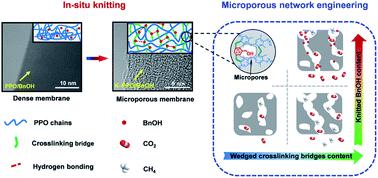当前位置:
X-MOL 学术
›
J. Mater. Chem. A
›
论文详情
Our official English website, www.x-mol.net, welcomes your feedback! (Note: you will need to create a separate account there.)
In situ knitted microporous polymer membranes for efficient CO2 capture
Journal of Materials Chemistry A ( IF 11.9 ) Pub Date : 2020-11-14 , DOI: 10.1039/d0ta08453k Yingzhen Wu 1, 2, 3, 4, 5 , Na Xing 1, 2, 3, 4, 5 , Sen Li 1, 2, 3, 4, 5 , Leixin Yang 1, 2, 3, 4, 5 , Yanxiong Ren 1, 2, 3, 4, 5 , Yutao Liu 1, 2, 3, 4, 5 , Xu Liang 1, 2, 3, 4, 5 , Zheyuan Guo 1, 2, 3, 4, 5 , Hongjian Wang 1, 2, 3, 4, 5 , Hong Wu 1, 2, 3, 4, 5 , Zhongyi Jiang 1, 2, 3, 4, 5
Journal of Materials Chemistry A ( IF 11.9 ) Pub Date : 2020-11-14 , DOI: 10.1039/d0ta08453k Yingzhen Wu 1, 2, 3, 4, 5 , Na Xing 1, 2, 3, 4, 5 , Sen Li 1, 2, 3, 4, 5 , Leixin Yang 1, 2, 3, 4, 5 , Yanxiong Ren 1, 2, 3, 4, 5 , Yutao Liu 1, 2, 3, 4, 5 , Xu Liang 1, 2, 3, 4, 5 , Zheyuan Guo 1, 2, 3, 4, 5 , Hongjian Wang 1, 2, 3, 4, 5 , Hong Wu 1, 2, 3, 4, 5 , Zhongyi Jiang 1, 2, 3, 4, 5
Affiliation

|
Microporous polymer membranes hold great promise in carbon capture. However, engineering a continuous CO2-selective microporous network to achieve ultrahigh gas permeance and desirable selectivity remains a grand challenge. Aiming to manipulate the pore architecture and pore chemistry to implement efficient separation, knitted microporous polymer membranes are fabricated by in situ knitting composite membranes comprised of polyphenylene oxide (PPO) polymer and benzyl alcohol (BnOH). Specifically, the crosslinkers, formaldehyde dimethylacetal, bridge the neighboring aromatic backbones of PPO chains and BnOH to construct a highly crosslinked network with microporosity. By increasing the structural bridge density, the BET surface area of membranes increases from 4 to 538 m2 g−1. The formation of a highly interconnected microporous network provides remarkably increased permeability. Meanwhile, BnOH as a hydroxyl-containing functional building unit is knitted into micropore skeletons, which can directly tune the pore size and improve the CO2-philicity for enhanced selectivity. The resulting membrane displays an ultrahigh permeability of 4651.2 barrer with a CO2/CH4 selectivity of 27, and demonstrated good resistance to plasticization (up to 30 bar) and aging (for 190 days). This knitting strategy enabling versatile combination of building units with different structures and special functionalities may set up an innovative platform for fabricating a broad range of advanced membranes.
中文翻译:

原位编织微孔聚合物膜可有效捕获二氧化碳
微孔聚合物膜在碳捕获方面具有广阔的前景。然而,设计连续的CO 2选择性微孔网络以实现超高的气体渗透性和理想的选择性仍然是一个巨大的挑战。为了操纵孔的结构和孔化学以实现有效的分离,通过原位编织由聚苯撑氧(PPO)聚合物和苯甲醇(BnOH)组成的复合膜来制造针织微孔聚合物膜。具体而言,交联剂甲醛二甲基乙缩醛桥接了PPO链和BnOH的相邻芳族骨架,以构建具有微孔性的高度交联的网络。通过增加结构桥密度,膜的BET表面积从4增加到538 m 2g -1。高度互连的微孔网络的形成提供了显着增加的渗透性。同时,将BnOH作为含羟基的功能性构建单元编织到微孔骨架中,可以直接调节孔径并提高CO 2的亲和性,从而提高选择性。所得膜显示出4651.2 barrer的超高渗透率,CO 2 / CH 4选择性为27,并表现出良好的抗塑化性(最高30 bar)和抗老化性(190天)。这种编织策略可以将具有不同结构和特殊功能的建筑单元进行多功能组合,从而可以建立一个创新的平台来制造各种先进的膜。
更新日期:2020-11-25
中文翻译:

原位编织微孔聚合物膜可有效捕获二氧化碳
微孔聚合物膜在碳捕获方面具有广阔的前景。然而,设计连续的CO 2选择性微孔网络以实现超高的气体渗透性和理想的选择性仍然是一个巨大的挑战。为了操纵孔的结构和孔化学以实现有效的分离,通过原位编织由聚苯撑氧(PPO)聚合物和苯甲醇(BnOH)组成的复合膜来制造针织微孔聚合物膜。具体而言,交联剂甲醛二甲基乙缩醛桥接了PPO链和BnOH的相邻芳族骨架,以构建具有微孔性的高度交联的网络。通过增加结构桥密度,膜的BET表面积从4增加到538 m 2g -1。高度互连的微孔网络的形成提供了显着增加的渗透性。同时,将BnOH作为含羟基的功能性构建单元编织到微孔骨架中,可以直接调节孔径并提高CO 2的亲和性,从而提高选择性。所得膜显示出4651.2 barrer的超高渗透率,CO 2 / CH 4选择性为27,并表现出良好的抗塑化性(最高30 bar)和抗老化性(190天)。这种编织策略可以将具有不同结构和特殊功能的建筑单元进行多功能组合,从而可以建立一个创新的平台来制造各种先进的膜。



























 京公网安备 11010802027423号
京公网安备 11010802027423号